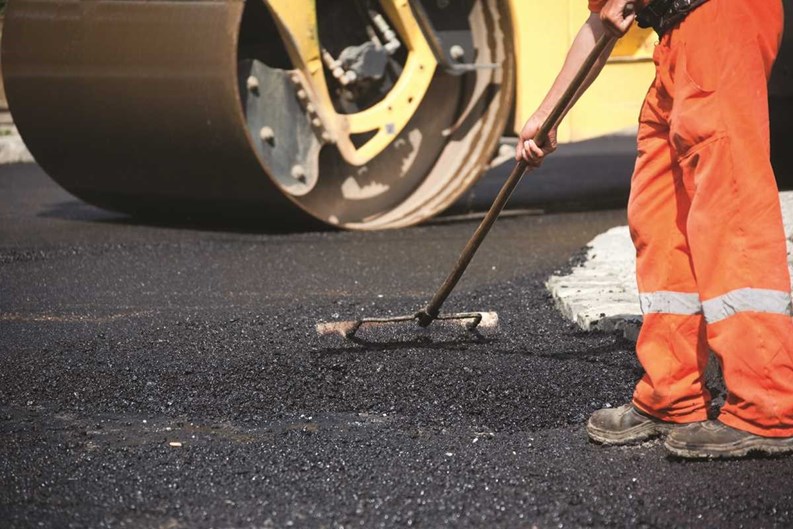How solid is the ground on which you walk and drive upon in your community? The answer might surprise you, as could the amount of money that might be seeping from your community’s reserve fund from unnecessary repairs to driveways, parking lots, and sidewalks.
Whether taking the form of sidewalks, parking lots and slabs, driveways, balconies, or outdoor design elements, paved surfaces are everywhere in New York’s co-op, condo and HOA communities. Caring for and repairing these acres of asphalt (as well as the community’s concrete sidewalks, decks and pavers, etc.), is a tedious task. The management has the responsibility of keeping the pavement outside the front doors in good shape; but it’s in the interest of everyone in a community to keep an eye on these parts of the infrastructure, as well.
Understanding the various materials, methods, and technologies involved in the paving located in a multifamily co-op, condo or HOA might seem purely the bailiwick of property management and not as much a concern of residents or board members. Still, it makes sense to save dollars. Having a clue on whether the asphalt parking lot needs a patching or a major renovation could save everyone in the building community or HOA time and money.
Firm Foundations
Knowing about paving means understanding the materials used for such projects. Just as some contractors are better at doing certain projects and not as great at working on other types of jobs, however, the correct material for the project may not be the one that seems best at the outset. Sometimes, when everyone is yelling for new asphalt, actually concrete is needed (or vice versa).
Generally speaking in New York residential communities, parking lots are asphalt, and sidewalks are concrete. The differences are distinct: asphalt is made of big and small rocks, sand, and petroleum; it’s flexible, and cures over six to 12 months. But strictly speaking, asphalt never really “sets up”—it stays flexible, unlike typical concrete, which becomes a solid, rigid surface after it cures.
Concrete is made of crushed stone, sand, and cement, and is often used for sidewalks and patios. Also, it can be used for parking lots, although some communities choose to pave these (and driveways) with asphalt, because it costs less than concrete in most cases.
There are advantages to using each of the materials, including life span and maintenance. If installed correctly, concrete has a 20-year life span (or longer); asphalt’s is shorter, depending on environmental conditions. The elements help wear down this material such as cold temperatures, rain, snow, and heat.
In New York’s temperamental climate, asphalt can become deformed. Occasionally, the combination of heavy vehicle traffic—like large trucks—can cause ruts in the heat-softened asphalt. Other factors, like snow and oil dripping from the engines of cars, can wear away at an asphalt surface and cause pitting.
“For example, if asphalt is not applied properly in a parking lot, water will get under it,” says John Denegall, vice president of Nico Asphalt Paving in Brooklyn.
Furthermore, according to experts, improper installation can be a fatal flaw in the longevity of an asphalt surface. If the asphalt is not installed at the correct temperature, it won’t cure properly.
Correct installation also includes a sealcoat (applying a sealer to the surface). This treatment should be done yearly, some experts recommend, to get the longest life out of the asphalt pavement. Usually, seal coats are one of two types: coal tar or a petroleum-based product called asphalt emulsion sealer.
Because asphalt paving costs less when building a new parking lot, or if the community is on a tight budget and the lot was paved in asphalt already, it makes sense to repair or repave in asphalt. Just because the community has an asphalt parking lot that needs replaced, however, doesn’t mean the best solution is asphalt paving for the new job. Sometimes, an overlay of two inches of concrete atop the existing asphalt pavement can be an effective remedy, experts say.
Consequently, a building’s management must count on their professional consultants with such quandaries. The more specific the questions regarding paving, the more these matters are referred to professionals. When it comes to spending thousands of dollars on a new parking lot (or another paved surface), it can be wise for board members to trust their property manager, and especially count on their engineer, in order to ascertain the right materials for the job.
It’s also important to recognize signs that the paved surface is breaking down as soon as possible. If caught early, the problem could mean a not-too-costly repair. If caught later, it might mean a total parking lot replacement, or even worse—a drainage system and parking lot replacement.
Noticing Cracks
In addition to rutting caused by heavy traffic and pitting caused by fluid leaks, asphalt can crack when breaking down, which could lead to a more pervasive problem. Surface cracks allow water into the underside of the pavement; then, it can collect in the subsurface and start breaking down the pavement.
The subsurface is the foundation of the asphalt; and, if compromised, the entire paved area may need replacing. Hence, an engineer (or other competent professional) must identify the exact nature of the problem. Occasionally, a community’s management and board simply bandage a problem…one that needs much more attention. Their engineers and other professional consultants need to advise them against this incongruity.
Just as with blacktopped roofs in cities, asphalt paving traps more heat than concrete, creating another potential disadvantage of using asphalt pavement in a residential community. It creates “urban heat islands,” says Bill Davenport, vice president of communications for the American Concrete Pavement Association based in Rosemont, Illinois.
“Urban heat islands can be 10 degrees to 20 degrees hotter than surrounding areas,” Davenport says. “The sun bakes down on those dark areas, which retain the heat, and sometimes never entirely cool off at night.”
Concrete paving—especially the traditional, impermeable kind that’s made of Portland cement—also is susceptible to water infiltration and the damage it causes. Therefore, even small cracks, or “spalling” (when the surface of the concrete begins to flake off), must be repaired immediately before a small fix turns into a major replacement.
Problems with concrete paving can begin the day of installation, or in the time following. A concrete mix must have the correct amount of water or the batch can be weakened. On an especially hot day, though, cement trucks sometimes get caught in traffic while delivering a batch and the driver must add water so the batch is still usable. On a state or federal highway job where an employee must test and approve each batch of cement, such a batch would be rejected.
But cement testers are almost nonexistent on residential projects, thus it is important for a board to ensure that the community’s engineering consultant oversees jobs, and the contractor is reliable and trustworthy.
Sidewalk Repair
All paved surfaces must be overseen by the property manager and engineer from installation and throughout their life spans. If the community is professionally managed, the manager or engineer should inspect all of the paving yearly. When this routine task is overlooked, another professional could be involved…the community’s lawyer.
In New York City, property owners are liable to maintain sidewalks and other paved surfaces. Under Administrative Code 7-210, “it shall be the duty of the owner of real property abutting any sidewalk, including but not limited to the intersection quadrant for corner property, to maintain such sidewalk in a reasonably safe condition.” This, according to legal experts, includes but is not limited to “the failure to reconstruct, repair or replace defective sidewalks and the failure to remove debris such as ice, snow or dirt from the sidewalk.”
While legal penalties are not common, lawyers who specialize in representing people who are injured from trip and fall hazards are common. Liabilities for such injuries could financially devastate a community that failed to properly maintain their paving. All a lawyer needs to prove is the community’s management should have known of the hazard and corrected it for the community to be liable.
At times, an attorney will use the community’s own covenants, which requires the property’s management to oversee maintenance of the community, as evidence against it while proving a trip and fall hazard liability. Improperly maintaining pavement can leave a community unprotected from such a lawsuit.
According to experts, certain seasonal maintenance steps must be taken to keep pavement in good shape. First, ensure that the drainage system taking water away from the pavement is clean and clear of debris so it doesn’t back up with water and cause problems. All parking lots must have debris removed and be swept clean. Landscaping around paved areas should be trimmed and disposed of, too. Finally, a seal coating should be applied to pavement if treatment is necessary (some communities do this yearly; others do it every other year).
Amy Miller, the vice president of national resources for the National Ready Mixed Concrete Association, points out that the concrete used in residential developments is one of three types. The most common is traditional (or Portland) cement; pervious concrete (which has voids in it, and enables water to trickle through, aiding in ecological storm-water management); and concrete overlays, which is when a layer of cement is installed atop an existing asphalt surface.
That is, providing the concrete is installed correctly in the first place. In addition to having the correct proportion of water to mix, the batch must be poured correctly and the sub-grade needs to be compacted properly. Another major installation flaw happens when the contractor doesn’t allow the concrete enough time to cure. It should set up to 2500 PSI, a process that could take three to seven days, depending on the mix.
It is essential that a community picks a qualified contractor for the job, Miller says. She suggests vetting the contractor first, checking with former clients, and reviewing jobs the company has done, as well as seeing if the firm has accreditation from the American Society of Concrete Contractors or other industry groups. You should also have the building’s engineer oversee the project, to see if things are done according to plan.
Jonathan Barnes is a freelance writer, who regularly contributes to The Cooperator. Freelance writer Christy Smith-Sloman contributed to this article.







2 Comments
Leave a Comment